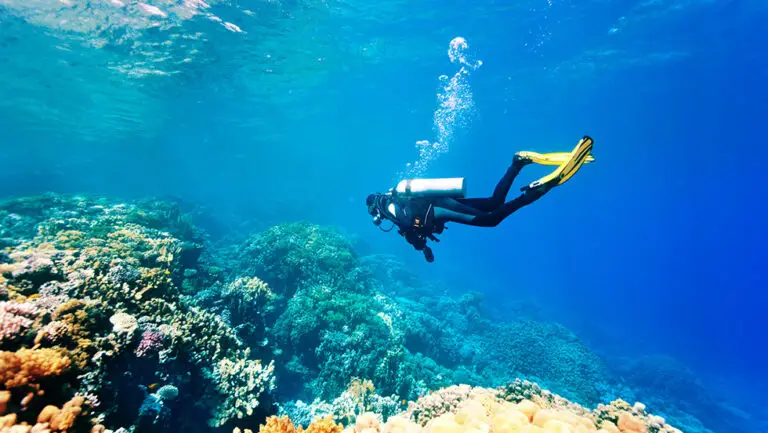If you’re planning an adventure to the Maldives, be sure to schedule an experience to go diving. Diving in Maldives is a once-in-a-lifetime experience that will give you up close access to some of the most stunning sea life around the world.
Beneath the surface of the Indian Ocean is a whole other world that most people only dream about.
We’ve put together this quick guide to help you discover everything that you should know about diving in the Maldives.
There is so much to see and experience, so keep reading to find out more!
Table of Contents
Top Things to Know About Scuba Diving in the Maldives
We’ve got a lot of information to share before you dive in the Maldives. Let’s start with a quick overview of the details we’re going to look at.
From the best dive sites to tips on what to expect, you will find all of the details below.
But first, take a look at these top takeaways from this diving in Maldives guide:
- Get to know the regulations and safety details
- You can typically dive throughout the year.
- See a variety of ocean life species
- Experience paradise from a whole new perspective
- Find out the best dive sites to choose from
- Learn a little about Maldives dive packages
Scuba Diving in Maldives – Safety, and Regulations

Safety first, right? This tropical paradise has so much to offer. Diving underwater in the open ocean is a great way to experience the adventures of the deep. But there are some safety details and Maldivian regulations to know before you explore.
Most travel planning agencies would recommend that you invest in travel insurance for this underwater adventure. While it’s rare that things go wrong, it is unpredictable, and it’s better to be safe than sorry.
Dives are typically closely monitored and regulated, but you don’t want to risk a mishap and not be covered.
Whether you are in shallow water or in the deep, you are likely going to be set up with breathing equipment for your dives. This equipment is regulated for your protection. It also takes some education for you to learn how they work and know the specifics to protect yourself when you dive.
Experienced divers and advanced divers know that even though it’s not their first time, there are risks to be aware of. It’s your life, so treat it carefully.
In general, these are the rules that divers and their guides will be expected to follow.
- You cannot dive within 12 hours of a scheduled flight. Your dive center will confirm this.
- New divers will not be able to go as deep and may not exceed 20 meters.
- Experienced or advanced divers can go up to 30 meters for recreational purposes.
- Dives in the Maldives cannot be longer than 60 minutes.
- A dive computer is required for Maldives diving experiences.
- Tourist dives are always paired with guides and instructors.
- You may be required to take a scuba review course before a Maldives scuba diving adventure.
These cover the majority of regulations. However, there are also some basic safety recommendations scuba divers should know.
- Never try to dive alone
- Equipment matters, and using the right equipment is essential
- Stay hydrated before and after your dive to prevent sickness or dehydration
- Respect and follow guides and instructors. They are there to help.
What is the Maldives Diving Season?

The best time to dive in Maldives is during their dry season. This is when the weather is most predictable, so the water is also most predictable. You are less likely to face strong currents. Strong currents can pose major risks, particularly when they are unexpected.
That being said, you can dive through the year. If you are a beginner, be mindful of the weather possibilities and how those might affect your diving experience. The southwest monsoon season will make diving more complicated too. In the atolls, currents flow from east to west. Because of this, the eastern areas tend to have more visibility.
However, from June to November, these change, as does the marine life in the area. This is the Northeast monsoon season and the rainy season, which could throw everything for a loop. Manta rays and whale sharks even change locations during this time of year.
Through the Northeast monsoon or rainy season, there is a much higher likelihood of strong winds that will affect the water too.
The good news is that the water temperatures are the same pretty much all year long. Those water temperatures only vary a few degrees throughout the year, and this includes underwater within the allowable diving depths. Those Northeast monsoon conditions rarely affect the temps. The southwest monsoon conditions also have little effect.
Year-round there are opportunities to enjoy a dive. However, be aware that year-round there are variations in animal patterns, weather patterns, and more.
Marine Life Expectations

There will be tons of marine life to see while you’re diving in the Maldives. Scuba diving takes you to this amazing underwater location that has reef sharks, whale sharks, manta rays, and so much more.
There is an entire world beneath the ocean surface, and you’re bound to experience it.
These are some of the marine life you might see while diving in Maldives:
- grey reef sharks
- whale sharks
- manta rays
- eagle rays
- whitetip reef sharks
- hammerhead sharks
- colorful fish
- moray eels
- tiger sharks
- coral reefs
- leaf fish
- sea turtles
The shark life you see the most in this area is those that live around the corals. It’s the same for the mantas. Most of them are harmless unless they feel threatened, but it’s important to be familiar with and know how to act in their presence before you explore.
Here is a closer look at some of these marine life species.

A Maldives island resort full of surprises. Sunkissed memories in the making. Adventure around every corner. This is Kurumba.
Reef Sharks

In terms of sharks, you might see hammerheads, tiger sharks, whale sharks, or gray reef sharks. These are the most common you will come across scuba diving. The grey reef sharks are definitely a top viewing at most dive site locations. Manta rays and whale sharks give them a close second.
Reef sharks typically will not be aggressive. They hide out around the caves and swim around the soft coral in Maldives. They only act out when they feel threatened or if they perhaps have young ones nearby.
The white tip reef shark is another top find, but they are less common in some areas. On the topic of sharks, we also mentioned hammerheads. You might see a hammerhead or two in some spots, but they won’t be as prominent as other sharks.
There are no white sharks in Maldives.
Mantas and Whale Sharks

When you dive in the Maldives, whale sharks and mantas will be another common site. Both the whale shark and the manta ray are impressive to look at. A whale shark is another species that likely won’t be aggressive unless they feel threatened. Most people plan their dive site experience in a season to get close to whale sharks and manta rays.
These are some of the most common marine life species of choice, from drift dives to deeper dives. Experts say the best time to see a whale shark or manta ray in the water is from February through April. Spot mantas and these sharks around the soft corals of Maldives.
Stingrays and eagle rays are less common, but they have been spotted before. Eagle rays are on the list of protected animals among manta rays.
Colorful Fish

We can’t leave out all the fish that hang out around the soft corals and the caves of the corals. There are so many brilliant colors. You will likely see fish that are from the same families as Nemo or Dory, but there will be plenty of others to experience too.
Tropical fish are known for their brilliant colors from the head to the tail. They are so incredibly unique in a lot of different ways too. Exactly what fish you see when you’re diving may depend on your location.
Each atoll has unique surroundings. They all have coral, blue waters, and other similar features. However, the life surrounding them and in the water around them can vary a little bit. If you really want the best diving experience or a way to change it up, try a night dive sometime.
See if you can catch a glimpse of a Napoleon wrasse fish. Napoleon wrasse is known as the king of the coral reef, and unfortunately, they are becoming harder to find.
You might also come across cleaning stations. Cleaning stations are a large grouping of marine animals that gather together to clean off bacteria, parasites, dead skin, and other things that might affect their health.
Turtles

The turtles are very important to the Maldivians. They love the caves but will explore vast parts of the ocean. Many resort locations have initiatives in place through their resort to protect and conserve sea turtle life.
There are several different turtle kinds you might find. Just know that the resort and Maldives have rules about them. You should also look into resort initiatives and get to know more about how they are protecting these beloved sea animals.
Here you can find the best eco-friendly resorts in Maldives.
The Top Dive Sites of Maldives
The big blue ocean is a humongous place. That crystal-clear blue water is spectacular no matter where you are. The best place to dive in Maldives will likely be a matter of opinion. However, heading out near the coral reefs is often a top choice.
If you’re looking for the best sites in the Maldives to dive at, check out some of these:
- Maaya Thila
- Cocoa Thila
- Fotteyo Kandu
- Banana Reef
- Fish Head
- Manta Point
- Hammerhead Point
- Hanifaru Bay
- Vaadhoo Caves
- Fuvahmulah Atoll
We mentioned Hanifaru Bay here, but it is a dive site that will be limited. The government has restricted how deep you can go at this particular dive site. You can still get in the water, and you simply can only go so far.
Each of these sites in the Maldives has unique things about them, as well as unique things you will see. They are all known for being great places to explore and find some incredible sites in Maldives. You will notice that life beneath the sea is similar at all of them.
The Best Atolls Dive Sites in Maldives
We’ve shared some really great spots, but we also want to point out that some of the Maldives atolls are well-known for their premier diving locations.
Take a look at these atolls in Maldives as you plan your diving adventures:
- North Male Atoll
- South Male Atoll
- Ari Atoll
- Baa Atoll
- Vaavu Atoll
- Rasdhoo Atoll
- Lhaviyani Atoll
- Addu Atoll
The North Male atoll and South Male atoll are some of the most popular areas because they are easy to get to. After all, Malé is the capital. From there, Ari atoll, Vaavu atoll, and Addu atoll are also top choices to be aware of. That being said, you can’t go wrong at any of these amazing locations.
Dive Sites and Packages for Diving in Maldives

Whether you head to North Male or another separate atoll in the Maldives, you can often invest in packages that might be beneficial for the cost prospect. It’s also quite common for the different resorts to offer package choices too.
We recommend that you start your Maldives planning by first determining what your resort offers. Then, if there are other places in Maldives you want to go diving, you can plan additional adventures.
Packages for Maldives are a great way to experience a lot and get the most out of your investment.
What to Expect From Diving in Maldives
Whether you’re planning to head into the depths, you just want to experience some swim-throughs, or you plan to try out drift diving, there are things to know. Both the north and southern areas of Maldives are equipped for divers to have a great experience.
However, divers would do well to set their expectations and know what to expect as well. Your site and the crew will be equipped to make this trip great. Most of the time, you will begin near the outer reef so as not to disturb things if you can avoid it.
Remember that you may see a reef shark or two. Don’t be disturbed or affected by a shark sighting. You need to do your best to maintain calm and just leave the shark in its own space.
You will likely travel a bit to your dive site. The reefs are a top site choice for divers because there is so much to see there.
Beginning divers, take a look at these simple tips:
- If wearing fins on land, try walking backward instead of forwards.
- Your gear will be heavy on land but light in the water.
- Make sure you equalize at the right time to avoid pain and discomfort.
- Do not try to touch or walk on any corals
- Your videos and photos may not be perfect because of water movement.
Time for an Adventure!
Going diving in Maldives is certainly a wonderful adventure. There are so many options, from drift diving to swim-throughs to other selections as well. No matter what experience you choose, you’re going to have an adventure. And it’s going to be something spectacular that you will remember for a lifetime.
Check out the best activities and things to do in Maldives.
Check Out the Best Offers to Maldives Resorts!
FAQ
What is the Best Diving Resort in Maldives?
There are many great choices. The Maayafushi Resort is closest to Maaya Thila, which is probably the most popular diving location in Maldives.
Is the Maldives Good for Scuba Diving?
It’s an amazing spot to go diving!
Can Beginners Dive in the Maldives?
Yes, they can. There are guides and instructors to lead you.
How Deep Do You Dive in Maldives?
Beginners can go to 20 meters, and experienced divers to 30 meters.
How Much Does Diving in Maldives Cost?
Typically the costs are anywhere from $70-$80 per person on average. Remember that looking into packages might help save money too.




















